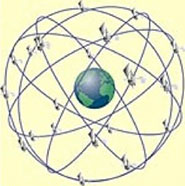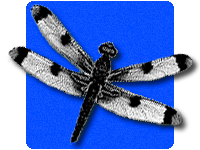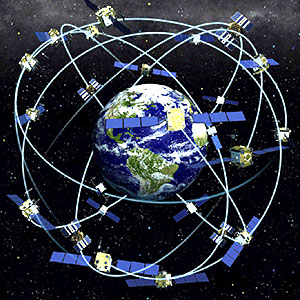Here’s a hobby where all you need is a $30 billion satellite system, and a handheld GPS device. Luckily, someone lent us the satellites!
Most Internet-related pastimes require us to sit at our computers far too long – games, chat rooms, weblogs, newsgroups – all demanding our interaction while we gaze at our screens and key in our words or actions. Now I’ve embraced an Internet hobby that demands far more from me: Geocaching. And geocaching pays me back in action for the time I invest.
Technologically Speaking…
 The Global Positioning System (GPS) is a space-based radio-navigation system consisting of a constellation of satellites and a network of ground stations used for monitoring and control. There are 24 GPS satellites in orbit around the Earth at altitudes of approximately 11,000 miles providing users anywhere in the world with accurate information on position, velocity, and time. GPS, formally known as the Navstar Global Positioning System, was initiated in 1973 to reduce the proliferation of navigation aids. By creating a system that overcame the limitations of many existing navigation systems, GPS became attractive to a broad spectrum of users worldwide. GPS has been successful in virtually all navigation applications, and because its capabilities are accessible using small, inexpensive equipment, GPS was utilized in a wide variety of applications across the globe. In order to retain access and control over the system, the government built-in a “degradation” of the signal which limited the system’s accuracy to about 300 yards – the length of three football fields. Government agencies could access the accurate signal, but individuals and other countries could not.
The Global Positioning System (GPS) is a space-based radio-navigation system consisting of a constellation of satellites and a network of ground stations used for monitoring and control. There are 24 GPS satellites in orbit around the Earth at altitudes of approximately 11,000 miles providing users anywhere in the world with accurate information on position, velocity, and time. GPS, formally known as the Navstar Global Positioning System, was initiated in 1973 to reduce the proliferation of navigation aids. By creating a system that overcame the limitations of many existing navigation systems, GPS became attractive to a broad spectrum of users worldwide. GPS has been successful in virtually all navigation applications, and because its capabilities are accessible using small, inexpensive equipment, GPS was utilized in a wide variety of applications across the globe. In order to retain access and control over the system, the government built-in a “degradation” of the signal which limited the system’s accuracy to about 300 yards – the length of three football fields. Government agencies could access the accurate signal, but individuals and other countries could not.
On May 1st, 2000 the Clinton Administration removed the signal degradation, giving a valuable gift to the world – the power of this global navigation technology – and opening up the possibility of games like geocaching.
You are the Search Engine!
 Using a handheld GPS device (about $100 and up), or an iPhone or Android App, geocachers can make their way to within about 10 to 20 feet of hidden caches – Tupperware containers, army field boxes, even magnetic hide-a-key boxes – and then find them, log their visit in the cache’s paper log book, and perhaps trade in and out for some of the contents. Later, an online log entry is also made for the cache on the Geocaching website, where a user’s stats and log entries are maintained.
Using a handheld GPS device (about $100 and up), or an iPhone or Android App, geocachers can make their way to within about 10 to 20 feet of hidden caches – Tupperware containers, army field boxes, even magnetic hide-a-key boxes – and then find them, log their visit in the cache’s paper log book, and perhaps trade in and out for some of the contents. Later, an online log entry is also made for the cache on the Geocaching website, where a user’s stats and log entries are maintained.
It’s Not About the Numbers!
When I checked the site at the time I posted this article (September 2, 2008), the current stats were:
 At the time of this posting, I’m currently at 123 cache finds – about 25 of them in Central Park, another several dozen in Midtown, the other boroughs, and New Jersey, and the rest in Tucson, Pasadena, Los Angeles, Italy and Slovenia (I’ve included my “live” stats link below, and you can see how many new finds I’ve added since writing this article. I’m “SilverMarc” on the Geocaching.com website). The geocoin pictured here is my personal “signature item” that I’ll leave in particularly interesting caches, or trade for other geocoins.
At the time of this posting, I’m currently at 123 cache finds – about 25 of them in Central Park, another several dozen in Midtown, the other boroughs, and New Jersey, and the rest in Tucson, Pasadena, Los Angeles, Italy and Slovenia (I’ve included my “live” stats link below, and you can see how many new finds I’ve added since writing this article. I’m “SilverMarc” on the Geocaching.com website). The geocoin pictured here is my personal “signature item” that I’ll leave in particularly interesting caches, or trade for other geocoins.
This weekend I’m off to a family gathering out of state, and I’m already set to trek through new wilds (as wild as New Jersey gets!) with my East Coast niece and nephew in search of hidden treasure. I can happily abandon the computer and head out on some adventures. The geocaching motto is clearly elegant: “You are the search engine.”

September 2, 2008 @ 12:30 PM
N 40° 48.165′ W 73° 57.37′ (my usual coordinates)
Marc Silverman is a Regional Administrator and Director Consultant for Manhattan BNI, Director of Web Development for MetroMac Alliance, produces, hosts, and maintains websites for local and nationwide firms, and hunts for geocaches in his spare time. He’d bet there’s one hidden near you!

